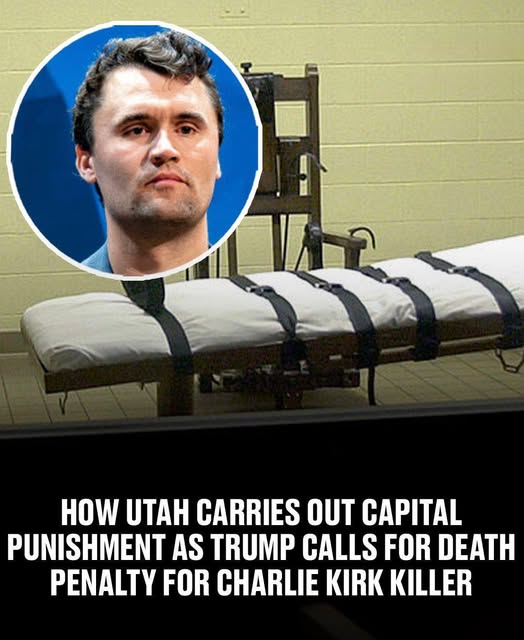Introduction
The criminal justice system in the United States is often shaped by high-profile events that spark public debate, influence policy discussions, and raise questions about fairness and morality. In Utah, the death penalty has returned to the center of attention following the arrest of 22-year-old Tyler Robinson, who was taken into custody in connection with the tragic killing of conservative activist Charlie Kirk during a public event at Utah Valley University.
While the loss of life itself is devastating, the broader story extends beyond the immediate circumstances. It has become the latest lens through which Utahns and Americans at large are reexamining capital punishment. Supporters argue that it serves as a necessary deterrent and a form of justice for the most heinous crimes, while critics highlight the legal, moral, and financial complexities that make the death penalty one of the most debated aspects of modern law.
This article explores the legal framework surrounding Utah’s death penalty, its historical roots, how it compares to other states, the moral arguments for and against its use, and the broader implications of the Robinson case.
The Legal Basis of Capital Punishment in Utah
Utah is one of 27 states in the United States where the death penalty remains legal. Under Utah law, capital punishment may be sought in cases of aggravated murder, which typically involve:
- Premeditated or deliberate killings.
- Murders committed during the commission of other serious felonies.
- Actions that put multiple people at significant risk of death.
In the Robinson case, prosecutors have emphasized that the incident took place in a crowded courtyard filled with thousands of attendees. While only one person was killed, the act itself endangered many others, which meets the statutory definition of aggravating circumstances. This is one reason state attorneys are weighing the possibility of seeking the death penalty if Robinson is convicted.
The methods of execution in Utah are unique compared to other states. Lethal injection is the default method, but firing squads are permitted in limited cases. This unusual option reflects Utah’s frontier history and continues to capture public interest, sparking debates about whether such practices belong in the 21st century.
Utah’s History with the Death Penalty
Utah holds a distinctive place in American death penalty history. It was the first state to reinstate capital punishment after the U.S. Supreme Court temporarily halted executions nationwide in the 1970s. Over the years, Utah has carried out several executions, some by firing squad, which has contributed to its reputation as a state with a unique approach to justice.
The most famous case was that of Gary Gilmore in 1977, who became the first person executed after the Supreme Court reinstated the death penalty in 1976. His execution by firing squad attracted international attention and remains a significant moment in U.S. legal history.
However, despite this legacy, Utah has carried out only a small number of executions in recent decades. The last one occurred in 2010, when Ronnie Lee Gardner was executed by firing squad. Since then, legal challenges, appeals, and broader shifts in public opinion have slowed the process dramatically.
Current Death Row in Utah
As of today, Utah has four men on death row. None have imminent execution dates, and their cases have been tied up in lengthy appeals that can stretch for decades. This slow process raises questions about whether the death penalty truly functions as intended.
Supporters argue that the long appeals are necessary safeguards to prevent wrongful convictions. Critics counter that the drawn-out process undermines the supposed deterrent effect of capital punishment and places enormous financial burdens on taxpayers.
National Context: Where Utah Stands
The United States has a deeply divided relationship with the death penalty. While 27 states, including Utah, retain it as a legal option, 23 states and the District of Columbia have abolished it. Among the states that still allow it, the frequency of executions varies widely.
- Texas, Florida, and Oklahoma are known for conducting executions more regularly.
- Utah, Colorado (until repeal), and Montana rarely carry them out, even though they remain technically available.
- States such as California maintain large death row populations but have not executed anyone in decades due to moratoriums.
This patchwork reflects broader debates about federalism, morality, and local culture. Utah’s unique blend of historical precedent and contemporary hesitation places it somewhere in the middle of the spectrum: executions are legally possible but practically rare.
Political Reactions and Public Debate
The Robinson case has ignited strong reactions. Utah Governor Spencer Cox reminded the public that capital punishment remains an available tool in the state’s justice system, emphasizing that prosecutors must consider it in cases that shock the conscience and endanger public safety.
Former President Donald Trump also weighed in, calling for the harshest penalty, which some observers interpreted as a political statement as much as a legal opinion. Such comments illustrate how high-profile cases often blur the lines between law and politics, raising questions about whether external pressures influence prosecutorial decisions.
Among the public, opinion is mixed. Some see the death penalty as a necessary expression of justice, especially when crimes involve public figures or mass endangerment. Others argue that life imprisonment without parole achieves the same level of safety without the moral and legal complications of execution.
Arguments in Favor of the Death Penalty
Supporters of capital punishment present several arguments, many of which resonate in Utah:
- Deterrence – Advocates argue that the possibility of death discourages would-be offenders from committing violent crimes.
- Retribution – For many, the death penalty represents society’s strongest condemnation of the most heinous acts.
- Closure for Victims’ Families – Some families of victims believe execution provides a sense of finality and justice.
- Public Safety – Executed offenders cannot commit further crimes, eliminating any risk of recidivism.
Arguments Against the Death Penalty
Opponents, however, present equally strong counterarguments:
- Risk of Wrongful Convictions – Numerous studies show that innocent individuals have been sentenced to death, raising grave concerns.
- Financial Burden – Capital cases are far more expensive than life imprisonment due to the lengthy appeals required.
- Moral Concerns – Many religious and ethical traditions question whether the state should take a life, even in response to murder.
- Inconsistent Application – Critics note that factors such as race, socioeconomic status, and geography can influence who receives a death sentence.
The Long Road of Capital Cases
Even if prosecutors seek the death penalty for Robinson, the outcome is far from immediate. Death penalty trials are complex, requiring multiple phases:
- Guilt Phase – Determining whether the defendant committed the crime.
- Penalty Phase – If convicted, deciding whether death is appropriate.
- Appeals Process – Automatic appeals can last for decades.
During this time, defendants often remain on death row for many years, sometimes outliving the families of their victims. This raises philosophical questions about whether justice delayed is justice denied.
The Broader Social and Moral Questions
The Robinson case, tragic as it is, has forced Utahns to reflect on broader questions:
- Does the death penalty serve as a deterrent in practice, or is it largely symbolic?
- Is it morally consistent for a society to punish killing by committing another killing?
- Are there better alternatives, such as life without parole, that balance justice with humanity?
- Should states like Utah continue to preserve unusual methods like the firing squad in a modern legal system?
These questions have no easy answers, but they highlight why the debate remains so persistent and emotional.
Conclusion: A System at a Crossroads
The death penalty in Utah stands at a crossroads. On paper, it remains a legal and powerful tool for addressing the gravest crimes. In practice, it is rarely used, with executions stalled by decades of appeals and mounting public skepticism.
The case of Tyler Robinson and the death of Charlie Kirk has reignited debate, but whether it will change Utah’s practical approach remains uncertain. What is clear is that capital punishment continues to challenge lawmakers, prosecutors, and citizens alike, forcing society to wrestle with profound questions of justice, morality, and the role of government in taking life.
As Utah navigates this case and its broader implications, it joins a nationwide conversation that is far from settled. The death penalty remains one of America’s most enduring, controversial, and consequential legal debates — and Utah, with its unique history and practices, remains firmly at its center.




